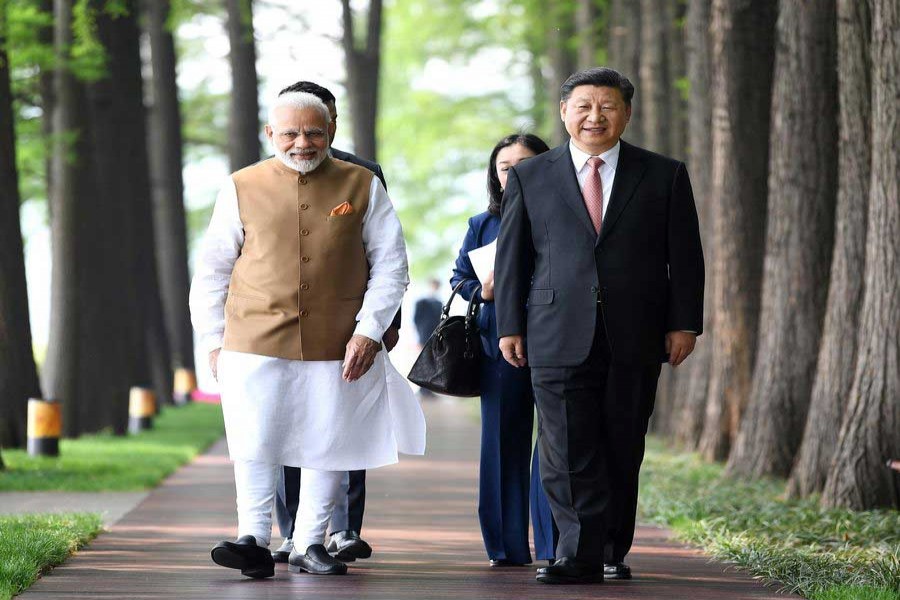When China and India first jointly pioneered the Five Principles of Peaceful Coexistence in a 1954 statement, they might not have imagined that their concerted advocacy efforts have helped breed one of the cornerstones of modern international relations.
Decades later, China and India have both grown into major players on the world stage, and respectively boast a population of over 1.3 billion. If the two countries join their hands even tighter for more energetic and pragmatic cooperation, they are very likely to produce more benefits for not only themselves but also the wider world.
As Chinese President Xi Jinping is travelling to the southern Indian city of Chennai on Friday to have an informal meeting with Indian Prime Minister Narendra Modi, they are expected to focus on real issues ranging from bilateral ties to shared challenges facing the two countries without the pageantry of a state visit, just as they did in China's central transport hub Wuhan in April last year.
Over the past one year and half, guided by the consensus reached by the two leaders in the Wuhan meeting, the development of bilateral ties has maintained a sound and stable momentum, which has injected certainty into the region and beyond.
More importantly, practical cooperation between the two sides is gaining steam. In 2018, bilateral trade volume reached a record high of 95.5 billion U.S. dollars. Over 1,000 Chinese companies are doing business in India, with a cumulative investment of 8 billion dollars.
As a breakthrough in bilateral cooperation, China-India pharmaceutical trade has been growing steadily. India has now become China's fourth largest trading partner in the area, and the largest exporter of raw medical materials to China.
Meanwhile, frequent exchanges in hi-tech and cultural sectors have electrified vitality for both markets. Indian movies such as "3 idiots," "Dangal" and "Secret Superstar" swept China's box office. In turn, China's tech company Xiaomi's Redmi smartphone series have topped the sales ranking in India. China's e-commerce giant Alibaba also provided technological know-how and financial support for India's endeavour to develope its largest mobile payment platform Paytm.
While bilateral cooperation is taking on a new and vigorous look, greater potential is yet to be tapped.
China is now the world's second largest economy, and India has been one of the fastest growing emerging market economies.
In recent years, both countries have prioritised structural reforms to boost economic development, create more jobs and improve people's well-being. As the two economies are highly complementary, China's development means ample growth opportunities for India, and vise versa.
The hi-tech sector can be a new growth point. As the age of 4th industrial revolution featuring big data and artificial intelligence is dawning, the two countries share both opportunities and incentives to ride global waves of a new technological transformation.
Infrastructure is another thriving area as the joint construction of the Bangladesh-China-India-Myanmar Economic Corridor has provided an effective framework to animate regional inter-connectivity and common development.
Cooperation between China and India has always transcended the scope of bilateral ties. It bears regional and global significance.
With the world's two most populous consumer markets, China and India hold in store tremendous business and investment opportunities for companies worldwide as they are struggling to cope with the rising tide of trade protectionism and economic nationalism.
Both as major developing nations, China and India also share a similar stance on eradicating poverty, combating climate change and cyber attacks, and safeguarding multilateralism in world affairs.
As long as the two countries can stick to the fundamental judgement that they pose each other no threats and offer each other chances for development, they can help maintain regional and global stability and prosperity.
To achieve that, the two neighbours need to properly manage their differences through existing communication channels, enhance political mutual trust, deepen mutual understanding and seek common ground on issues concerning their respective core interests.
When Xi first met Modi ahead of the 2014 BRICS summit in Brazil, he told the Indian leader that "If the two countries speak in one voice, the whole world will attentively listen; if the two countries join hand in hand, the whole world will closely watch." His assertion is even truer today.


